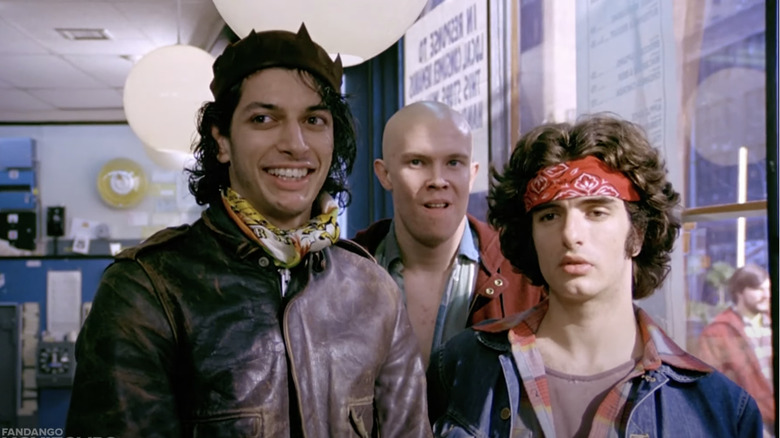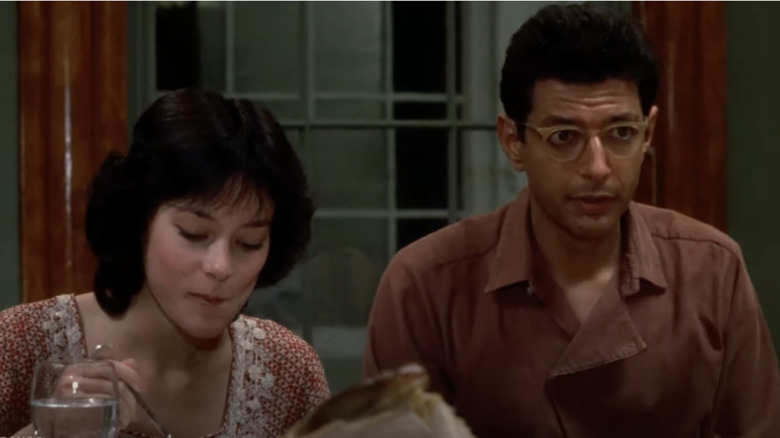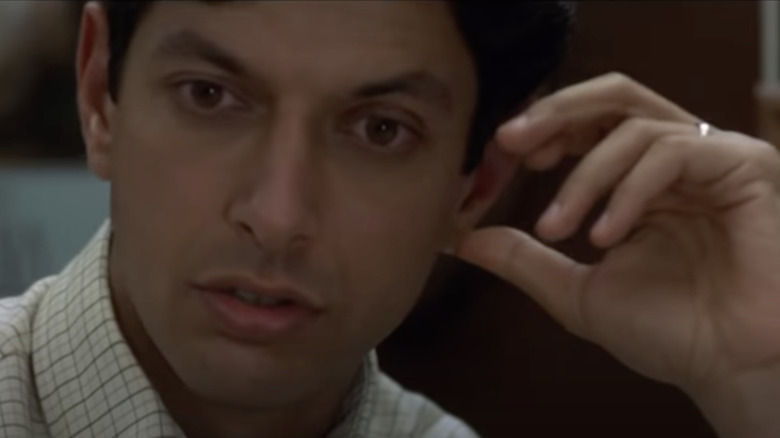The Most Forgotten Film And TV Roles Of Jeff Goldblum
Jeff Goldblum has been a household name for nearly 40 years. To many, the Pittsburgh-born actor first made himself known in David Cronenberg's 1986 body-horror remake of 1950s classic "The Fly"; for others, perhaps it was Lawrence Kasdan's 1983 classic "The Big Chill," about as different a film as one could imagine. Still more, possibly, remember him driving that crazy motorcycle in Robert Altman's 1975 masterpiece "Nashville." If nothing else, it was clear early on that this lanky, wild-eyed actor had a knack for working with top-notch filmmakers.
Wherever viewers first took notice, there's no doubting that "The Fly" took his career to the next level, and he hasn't looked back since. Those early films paved the way for the sort of funny, brilliant, eccentric characters Goldblum has since perfected, from cynical mathematician Ian Malcolm in the "Jurassic Park" films to the alien warlord Grandmaster in "Thor: Ragnarok" to himself in the Disney+ docuseries "The World According to Jeff Goldblum."
Contrary to what some may believe, Goldblum was not grown in a lab on the set of "The Fly." He worked in film and television for more than a decade prior to his mid-'80s breakthrough, and in the years since has flexed his genre muscles as everything from a private eye to a Hong Kong Cavalier. Let's take a look at some of the largely forgotten early film and television roles that helped develop one of the most beloved character actors in modern Hollywood.
Death Wish (1974)
Goldblum made his film debut in the 1974 urban thriller "Death Wish" in a small but vital role as "Freak #1." He and the two other likewise unnamed but colorfully dressed street toughs spot well-to-do Joanna Kersey (Hope Lange) and her daughter Carol (Kathleen Tolan) at the grocery and follow them home. They break into the Kerseys' Manhattan apartment in broad daylight, sexually assaulting both women, killing Joanna and leaving Carol in a trauma-induced coma.
This attack devastates head of the family Paul (Charles Bronson), a bleeding-heart liberal now forced to face the depraved state of the world. In retaliation, Paul takes to the streets at night, gunning down would-be muggers and assailants. Soon, the police get involved, but what are they to do when so many citizens approve of this vigilante's methods?
Obviously, this is a film meant to provoke strong reactions; Roger Ebert called it "quasifascist" in the first line of his three-star review, finding its politics repugnant but its execution thrilling. Director Michael Winner pulls no punches, literally or otherwise, when depicting violence. The scene where Joanna and Carol are attacked is especially difficult to watch, but what's notable about it is that this is the last time we see Goldblum and his partners (Christopher Logan and Gregory Rozakis). They are not arrested, no one knows who they are, and Paul never catches up with them again as a vigilante, even by accident.
Although Goldblum was barely in the film, his actions would propel Paul Kersey's one-man mission through 5 "Death Wish" films. Later installments in the series would aim Paul's vengeance more specifically, but here he is lashing out at an entire city, if not an entire society.
California Split (1974)
That same year, Goldblum made a brief appearance in the Robert Altman gambling drama "California Split."
George Segal plays Bill, a California magazine writer with a slight gambling problem, who one night at a poker table crosses paths with professional gambler Charlie (Elliott Gould). The two have an immediate rapport, strengthened by getting beaten up together by an angry poker player who thought they were in cahoots. Before long they are spending much of their time together at tracks, casinos, betting halls, chasing that one perfect score as their lives swirl further and further down the drain. The plot, however, is secondary to the wonderful sense of texture that Altman brings to every scene, courtesy of his trademark overlapping dialogue tracks, non-actors performing alongside pros like Segal and Gould, and sunlight-through-cigarette-smoke photography by Paul Lohmann.
Goldblum plays Bill's baby-faced publisher at the magazine, the kind of man who makes an honest day's work seem terribly unappealing; Bill calls him "the Dauphin" behind his back, and the other employees grouse about his editorial decisions. In his one scene, he sticks his head out from his office to ask secretary Barbara (Barbara Colby) if Bill has arrived in the building yet, then sheepishly withdraws back into the office. It's a small moment, but Goldblum's oddball energy makes it memorable. Altman would use that energy to more productive ends very soon.
Nashville (1975)
A year after "California Split," Altman released his Bicentennial epic "Nashville." Taking place across five days in the eponymous Tennessee capitol, Altman weaves together over two dozen speaking roles into a tapestry of celebrities, wannabes, has-beens, never-weres, hangers-on, and working folks just trying to make it through the day. It's a work of structural genius, one that rewards multiple viewings to get the full effect. The film plays as a kind of hub-and-spoke style of storytelling, with its central characters — a fragile superstar (Ronee Blakely), a caddish folk rocker (Keith Carradine) and an unhappy wife (Lily Tomlin) to name just a few — bound together in ways both known and unknown.
Goldblum's character, credited only as "Tricycle Man," fits into that unknown category. A silent man riding around town on a three-wheeled chopper, he turns up just about everywhere, usually in the background. If he didn't interact directly with some of the characters, giving runaway housewife Albuquerque (Barbara Harris) a lift or doing a magic trick for aspiring singer Sueleen (Gwen Welles), he might seem like a figment of our imagination. Even for 1975, his hippie style is a little out of date, as if he were the spirit of the '60s, still lingering in the back of our minds, not quite snuffed out by '70s malaise.
Invasion of the Body Snatchers (1978)
Don Siegel's 1956 paranoid sci-fi classic "Invasion of the Body Snatchers" got a Me Generation makeover courtesy of director Philip Kaufman in 1978. The main strokes of the premise remain the same from the original: Aliens have arrived on Earth and are taking over by assuming the identities of humans one by one. These replacement people, incubated in organic pods, look, sound and have the memories of those they have replaced, but with a cold, emotionless affect. San Francisco health inspectors Matthew (Donald Sutherland) and Elizabeth (Brooke Adams), their married friends Jack and Nancy (Goldblum and Veronica Cartwright), and a New Age author (Leonard Nimoy) have discovered the truth. The only problem is that there is no way to tell who has been replaced by a pod person.
Where the '50s original simultaneously indulged in and satirized Cold War paranoia, Kaufman's remake updates its target to Baby Boomer selfishness and the death of the utopian ideals of the '60s, symbolized by its San Francisco setting. By becoming government employees — working for The Man — Elizabeth and Matthew are already pod people in a sense, while Jack and Nancy's embrace of New Age philosophy and UFO theories make them unexpectedly prepared to weather an alien invasion. Goldblum's Jack is the prototype of his Cool Nerd persona, all stammers and jangled nerves, as in the scene where he discovers his own developing pod person. The film's power comes from the futility of our heroes' efforts to stop the invasion, leading up to one of the most bleak and terrifying endings in movie history.
Thank God It's Friday (1978)
A disco musical riding on the coattails of "Saturday Night Fever," 1978's "Thank God It's Friday" is a wisp of a movie, barely 90 minutes long, and whatever plot it has exists as an excuse to string as many disco hits one after another as possible.
Taking place over the course of one wild night at the hottest club in town, the film follows several storylines at once. While a couple of nerds (Chuck Sacci, songwriter Paul Jabara) try unsuccessfully to score with women at the bar, the club's sleazy owner Tony (Goldblum) has a bet going with the DJ (Ray Vitte) that he can seduce bored housewife Sue (Andrea Howard) away from her boring husband (Mark Lonow). Goldblum doesn't seem entirely comfortable in Tony's velvet suit; he seems a little uptight for the character as written, though he does land some sold comic beats, as when he tries to make a final declaration of love to Sue but keeps being interrupted by his other paramours.
If the film is remembered for anything, it is for the smash radio hit that it spawned. Disco queen Donna Summer appears in the film as Nicole, an aspiring singer trying to catch the DJ's eye. At the end he finally relents and lets Nicole sing a song, which turns out to be "Last Dance," which not only made it to #3 on the Billboard Hot 100 and became a standard of the genre, but won a Golden Globe and Academy Award for Best Original Song in 1979.
Tenspeed and Brown Shoe (1980)
Television had been part of Goldblum's career from the beginning, as he appeared on episodes of "Columbo" and "Starsky and Hutch" in between film roles. In 1980 he landed his first lead role on a new series, "Tenspeed and Brown Shoe," a throwback detective show from the mind of TV writer extraordinaire Stephen J. Cannell ("The Rockford Files").
Goldblum plays Lionel Whitney, a young accountant with a romantic streak who dreams of being a private eye like his 1940s paperback heroes, so he opens up his own detective agency alongside veteran con man E.L. "Tenspeed" Turner, played by Broadway star Ben Vereen. Together they prowl the mean streets of modern day Los Angeles in sharp three-piece suits, with Turner too often saving Whitney from his own boyish enthusiasm.
The fourteen-episode series premiered in January 1980 on ABC, originally airing on Sunday nights before getting moved to Fridays that May. Viewership declined sharply after the first few episodes, and ABC declined to renew the show for another season. Cannell would go on to create many, many popular shows in the 1980s, including "The A-Team" and "21 Jump Street," and Vereen would end up reprising his role as Tenspeed in one of them, the 1988 Texas detective series "J.J. Starbuck."
The Legend of Sleepy Hollow (1980)
Was there ever a more Ichabod Crane-looking actor than Jeff Goldblum circa 1980? NBC felt that way when they produced this adaptation of the classic Washington Irving short story.
Airing on Halloween night in 1980, the film follows scaredy-cat schoolmaster Ichabod Crane as he moves to the upstate New York hamlet of Sleepy Hollow and finds himself competing with local bully Brom Bones for the affections of the lovely Katrina Van Tassell. Brom fills Ichabod's head with stories of the Headless Horseman, a spectral soldier who rides an evil horse through the woods at night, in an attempt to scare him off. But those stories can't possibly be real ...can they?
"The Legend of Sleepy Hollow" is an awfully slim story to build a 100-minute movie from, which is one reason why Tim Burton's 1999 adaptation grafts a murder mystery onto the structure. Here, it results in a lot of added scenes of Ichabod's adventures with the townsfolk, often ending with someone falling into the snow, and a new female character (Laura Campbell) to turn the central love triangle into a square. Never released on DVD, the film exists now mostly in the memories of '80s babies and a few YouTube clips ripped from someone's VHS copy.
Threshold (1981)
Even further down the VHS memory hole from "Sleepy Hollow" lies "Threshold," a Canadian medical drama/sci-fi film reuniting Goldblum with his "Invasion of the Body Snatchers" co-star Donald Sutherland. Produced in 1981, it was released on VHS but never on DVD in either the US or Canada, nor is it currently available on any streaming platform. A poor VHS rip of the entire film is on YouTube as of February 2022, but otherwise the film is nearly lost to history — which is a shame, as it is a solidly acted, meat-and-potatoes procedural revolving around the ethics of the world's first artificial heart transplant.
Goldblum plays Dr. Aldo Gehring, a controversial biologist who believes he has cracked the code to making a viable artificial heart. Sutherland plays the esteemed cardiovascular surgeon who signs on to Aldo's methods, and a young Mare Winningham plays the patient who will die if the two are not successful. Richard Pearce ("Leap of Faith") directs with a clean, unfussy style, and novelist James Salter's ("Downhill Racer") script is punched up by Goldblum's "excess of personality," to quote another film that would cast him as an unconventional scientist.
The Big Chill (1983)
Lawrence Kasdan's Boomer classic "The Big Chill" boasts one of the great acting ensembles of the last 40 years, with Glenn Close, Kevin Kline, William Hurt, Tom Berenger, JoBeth Williams and more as a group of 30-somethings reunited when one of their college friends (Kevin Costner, though his face is never seen) takes his own life. Goldblum is just one among an entire cast of heavy-hitters, and he slots in well as one of the gang. It isn't that he tamps down his natural charisma and oddball energy so much as he adjusts it to the wavelength of the group.
Their friend's death sends this group of former '60s radicals and utopians reeling as they reevaluate their lives since college, wondering where it all might have gone wrong. Each of them carries their own baggage, from Meg's (Mary Kay Place) desire to use one of the men present as a surrogate father, to Nick's (Hurt) impotence, physical and otherwise, since returning home from Vietnam, to Michael (Goldblum) hitting up his former friends for investments in the nightclub he dreams of opening. Ultimately, though, they find solace and healing in each other, in their idealism, and in one of the biggest soundtrack albums of all time.
The Adventures of Buckaroo Banzai Across the 8th Dimension (1984)
If Goldblum's restrained ensemble turn in "The Big Chill" felt like something of a missed opportunity considering his unique set of skills, his role in the 1984 ready-made cult classic "The Adventures Buckaroo Banzai Across the 8th Dimension" more than makes up for it. A musical comedy sci-fi adventure, "Buckaroo" goes in as many directions at once as its polymath hero (Peter Weller), a biracial doctor/physicist/rockstar/comic book hero whose experiments in alternate dimensions get our reality caught up in the war between red and brown Electroids from the 8th Dimension.
One of the film's more inspired twists is how Buckaroo and his exploits are already well known and celebrated; it plays almost like a sequel to itself. Goldblum's character, Dr. Sidney Zweibel, is starstruck by Buckaroo and his band/sidekicks The Hong Kong Cavaliers, guys with names like Perfect Tommy (Lewis Smith) and Rawhide (Clancy Brown); when he is asked to join them he breaks out his best 1930s cowboy duds for the occasion. Goldblum also gets perhaps his first opportunity to deliver a rambling monologue that ends with a shocking revelation, something that would become a treasured part of his repertoire.
Into the Night (1985)
In this semi-forgotten John Landis caper from 1985, Goldblum plays Ed Okin, an insomniac aerospace engineer who gets mixed up with a beautiful jewel thief (Michelle Pfeiffer) on the run from the Iranian government and a British assassin played by David Bowie. The film fits neatly into a mini-trend in the mid-to-late '80s of movies about uptight guys being led on a wild nocturnal adventure by a beautiful woman, such as Martin Scorsese's "After Hours," the Bruce Willis comedy "Blind Date," and Jonathan Demme's "Something Wild." While Goldblum and Pfeiffer acquit themselves well here, and are naturally charming enough to elevate even the worst material, the film doesn't give them much else to do — Goldblum especially — besides reacting to the crazy things happening around them.
Reviews at the time were mostly negative, with many critics taking issue with Landis' inside-baseball gimmick of casting famous directors in bit parts and cameos, including David Cronenberg, Jim Henson, makeup artist Rick Baker, and Landis himself (in a truly unfortunate decision) as an Iranian goon. Roger Ebert called it "autoerotic" in his one-star review, though still finds praise for Goldblum and Pfeiffer. Luckily, they survived this debacle.
Transylvania 6-5000 (1985)
The supernatural comedy "Transylvania 6-5000" received abysmal reviews when it was released in 1985 and became a notorious shorthand for "stinker" films for awhile, but for a certain generation raised on basic cable reruns, there is a nostalgic charm that transcends notions of taste or quality. Nostalgia is baked into the film's premise, its visuals, and even its title, a play on the big band standard "Pennsylvania 6-5000" (a joke that Looney Toons had already made 20 years earlier). Goldblum stars as a tabloid reporter with aspirations of serious journalism, sent to Transylvania along with his editor's idiot son (Ed Begley, Jr.) to investigate sightings of a Frankenstein-like creature.
This very cheap production, financed by Roger Corman's New World Pictures, benefits from casting a bevy of actors either on the cusp of stardom (Goldblum and his soon-to-be "The Fly" co-star Geena Davis), actors who will become stars in the near future ("Seinfeld" star Michael Richards as a deranged bellhop), or comic ringers who can reliably elevate dreadful material (Carol Kane, Begley, Jr.). And while it isn't a ripoff of "Ghostbusters" per se, the influence of that 1984 mega-hit certainly shows, especially in Goldblum's sarcastic character, who may as well have "The Bill Murray Role" written on his shirt.












